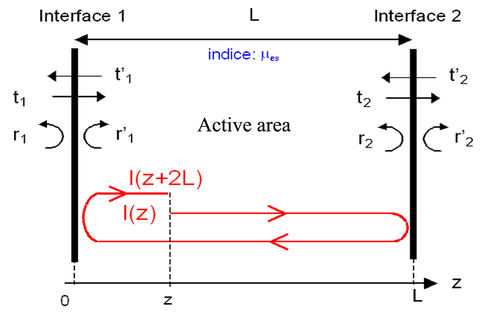
Threshold Gain and Authorized Longitudinal Modes
A laser diode can be imitated by an active environment of length L defined by interfaces 1 and 2, which form the Fabry-Pérot cavity.

These interfaces are characterized by their reflection coefficients r and r' and their transmission coefficients t and t' in amplitude of the electric pathway. We will note
 as the effective sign of phase refraction without retro-injection.
as the effective sign of phase refraction without retro-injection.
The optical intensity flux I(z) follows an exponential law in
 où
où
 is the absorption coefficient of the active environment, g is the gain of this environment and
is the absorption coefficient of the active environment, g is the gain of this environment and
 is the loss coefficient owed principally to the absorption by free carriers (i.e. the Auger effect.)
is the loss coefficient owed principally to the absorption by free carriers (i.e. the Auger effect.)
The condition of laser emission is obtained as soon as the electric pathway associated with this flux is stabilized in its amplitude and phase by a return-trip to the active cavity where :
Where
 is the threshold gain without feedback
is the threshold gain without feedback
 is the emission frequency without feedback, and c is the velocity of the light in the void.
is the emission frequency without feedback, and c is the velocity of the light in the void.
The resolution of this equation in module and phase brings us to the threshold gain and to the frequency of authorized emissions.
A distinct authorized frequency corresponds to each value for u which is therefore a distinct longitudinal mode of possible laser emission. Careful, this study predicts nothing of the optical energy associated with each of these modes, which are theoretically infinite in number (numerous laser diodes are monomode).
A distinction should be made between the sign of the phase refraction
 and the sign of group refraction
and the sign of group refraction
given that the environment sign is dependent upon the wavelength. So, we say that it is dispersive. Here is the difference in emission frequency between two authorized modes :